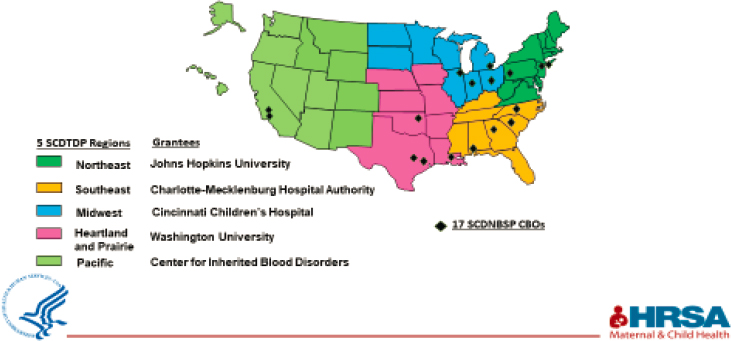Appendix H
Health Resources and Services Administration Sickle Cell Disease Programs
OVERVIEW OF SICKLE CELL DISEASE PROGRAMS
Sickle Cell Disease Treatment Demonstration Program (SCDTDP): Improve the health outcomes of individuals with sickle cell disease (SCD), reduce morbidity and mortality caused by SCD, reduce the number of individuals with SCD receiving care only in emergency departments, and improve the quality of coordinated and comprehensive services to individuals with SCD and their families.
Sickle Cell Disease Newborn Screening Follow-Up Program: To ensure that individuals diagnosed with SCD through newborn screening receive appropriate follow-up services including counseling, education, access to a medical home, and other support services.

NOTE: CBO = community-based organization; SCDNBSP = Sickle Cell Disease Newborn Screening Follow-Up Program; SCDTDP = Sickle Cell Disease Treatment Demonstration Program.
SOURCE: PowerPoint presentation provided via email communication to National Academies staff by Edward Ivy, Medical Officer, Maternal and Child Health Bureau, Health Resources and Services Administration.
TABLE H-1 Programs at a Glance
| Sickle Cell Disease Treatment Demonstration Program | Sickle Cell Disease Newborn Screening Follow-Up Program | |
|---|---|---|
| Program Objectives |
|
|
| Scope |
|
|
continued
TABLE H-1 Continued
| Sickle Cell Disease Treatment Demonstration Program | Sickle Cell Disease Newborn Screening Follow-Up Program | |
|---|---|---|
|
TABLE H-1 Continued
| Sickle Cell Disease Treatment Demonstration Program | Sickle Cell Disease Newborn Screening Follow-Up Program | |
|---|---|---|
| Results |
Access to care:
|
|
Hydroxyurea use:
|
||
Knowledgeable providers:
|
SOURCES: PowerPoint presentation provided via email communication to National Academies staff by Edward Ivy, Medical Officer, Maternal and Child Health Bureau, Health Resources and Services Administration. Also see https://www.nichq.org/sites/default/files/inline-files/NICHQ-SCDTDP-ImpactStatement_0.pdf (accessed December 17, 2019).
This page intentionally left blank.






